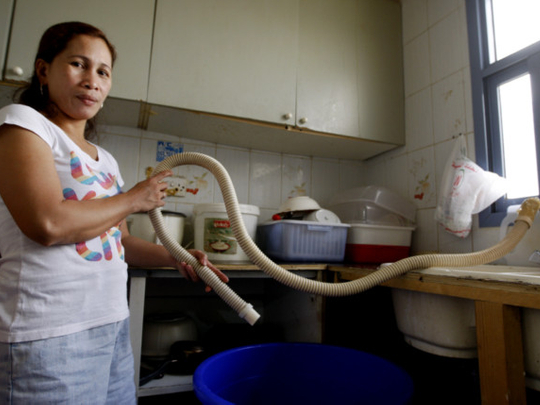
Dubai: Following a prompt investigation, tenants at Al Fardan Building in Satwa — who had no water connection in their building for two weeks — had their water supply reconnected on Wednesday morning.
The Dubai Electricity and Water Authority (Dewa) yesterday carried out an in-depth investigation at Al Fardan Building after Gulf News reported that tenants were left with no other option than to collect water from the building next door, in order to take showers and wash their clothes.
According to Dewa’s investigation, the building is over 30 years old with a main meter that caters to 46 flats, with more than 300 occupants.
The maintenance firm responsible for the building also confirmed that the water connection was reconnected, although they declined to reveal further information.
“On Tuesday night there was very little water coming from the taps, but I was extremely relieved when I woke up this morning and found that the connection was back to normal,” said Chitra Nair, a tenant.
“Apparently, the building owner, due to a likely leakage in the underground tank [of 4,400 gallons] has decided to bypass this tank and install a pump after the main meter of the building, which is illegal, in order to pump the water directly to the overhead tanks,” Khawla Al Muhairi, Vice- President, Marketing and Corporate Communications at Dewa, told Gulf News on Wednesday.
”Our technicians found that the capacity of the underground tank and overhead tanks are insufficient to cope with the high demand of the building due to its high illegal occupancy, which has led to the complaints of the tenants, and the resulting water shortage,” she said.
Khawla explained that the owner should respect the law by allowing a reasonable number of occupants per flat, for which the building is designed.
“However, rather than maintaining and expanding the capacity of the underground tank, which seems to be in a very bad shape, the owner decided to install a pump after the main connection to pump the water directly to the overhead tank,” she said.
“Doing this is illegal and has affected the water flow to the building, as the capacity of the overhead tanks is very small when compared to the demands of so many tenants,” said Khawla.
She also emphasised that owners should comply with the applicable laws and regulations in terms of demand per capita and number of occupants per flat per building and, of course, building codes and regulations.
To prevent similar incidents, Dewa urges building owners to follow the regulations and ensure that the building occupancy is within the proper limits.
Building owners should also secure the necessary permits and No Objection Certificate in order to install the proper storage capacity for the underground and overhead tanks to meet the 24-hour demands of the building residents.










